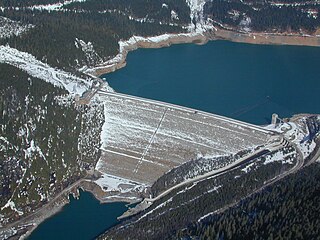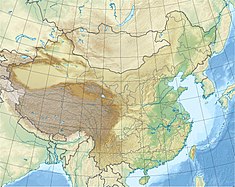
The Xiluodu Dam is an arch dam on the Jinsha River, i.e. the upper course of the Yangtze in China. It is located near the town of Xiluodu in Yongshan County of Yunnan Province but the dam straddles into Leibo County of Sichuan Province on the opposite side of the river. The primary purpose of the dam is hydroelectric power generation and its power station has an installed capacity of 13,860 MW. Additionally, the dam provides for flood control, silt control and its regulated water releases are intended to improve navigation downstream. Construction on the dam and power station began in 2005 and the first generator was commissioned in 2013, the last in 2014. It is operated by China Yangtze Power and is currently the third-largest power station with the fourth-tallest dam in the world.

Nuozhadu Dam is an embankment dam on the Lancang (Mekong) River in Yunnan Province, southwest China. The dam is 261.5 m (858 ft) tall, and creates a reservoir with a normal capacity of 21,749,000,000 m3 (17,632,000 acre⋅ft) at a level of 812 m (2,664 ft) asl. The purpose of the dam is hydroelectric power production along with flood control and navigation. The dam supports a power station with nine generators, each with generating capacity of 650 MW. The total generating capacity of the power station is 5,850 MW. Construction on the project began in 2004; the dam's first generator went online 6 September 2012 and the last generator was commissioned in June 2014. The construction and management of the project was implemented by Huaneng Power International Ltd., which has a concession to build, own and operate hydroelectric dams on China's stretch of the Mekong River.

The Laxiwa Dam is an arch dam on the Yellow River in Qinghai Province, northwest China. It is 32 km (20 mi) downstream of the Longyangxia Dam and 73 km (45 mi) upstream from the Lijiaxia Dam. The main purpose of the dam is hydroelectric power generation and it supports the largest station in the Yellow River basin. The facility generates power by utilizing six turbines, each with a generating capacity of 700 MW, totaling to a capacity of 4,200 MW.

The Guandi Dam is a gravity dam on the Yalong River, a tributary of the Yangtze River in Sichuan Province Southwest of China. It supplies water to four hydroelectric generators, each with generating capacity of 600 MW. The total generating capacity of the project is 2,400 MW. Construction started on October 20, 2010 with a ground-breaking ceremony. On February 9, 2012 the dam began to impound the reservoir and the last of the four generators were commissioned on 28 March 2013.

The Shuangjiangkou Dam(Chinese: 双江口大坝/双江口水电站), also referred to as Shuang Jiang Kou(Chinese: 双江口), is an embankment dam currently being constructed on the Dadu River in Sichuan Province, China. When completed, the 312 metres (1,024 ft) tall dam will be the tallest dam in the world. Preliminary construction began in 2008 and the entire project is expected to be complete in 2018. By April 2011, over 200,000,000 m3 (261,590,124 cu yd) of material had been excavated from the construction site. In March 2013 the China's Ministry of Environmental Protection approved construction on the dam's superstructure and associated facilities. The government acknowledged that the dam would have negative impacts on the environment but that developers were working to mitigate them. The dam is being built by the Guodian Group at a cost of US$4.02 billion. The entire construction period is expected to last 10 years.

The Longyangxia Dam is a concrete arch-gravity dam at the entrance of the Longyangxia canyon on the Yellow River in Gonghe County, Qinghai Province, China. The dam is 178 metres (584 ft) tall and was built for the purposes of hydroelectric power generation, irrigation, ice control and flood control. The dam supports a 1,280 MW power station with 4 x 320 MW generators that can operate at a maximum capacity of 1400 MW. Controlling ice, the dam controls downstream releases to reservoirs lower in the river, allowing them to generate more power instead of mitigating ice. Water in the dam's 24.7 billion m3 reservoir provides irrigation water for up to 1,000,000 hectares of land.

The Ankang Dam is gravity dam on the Hanjiang (Han) River near Ankang in Shaanxi Province, China. The main purpose of the dam is hydroelectric power production along with other purposes such as flood control and navigation. The dam withholds a 2,580,000,000 m3 (2,091,640 acre⋅ft) reservoir which supplies water to its powerhouse located on the right toe. The power station contains 4 x 200 MW generators for a total installed capacity of 800 MW. On the dam's surface adjacent to the power house are five controlled spillway chutes. The dam also houses five mid-level openings and four base openings for discharging water as well.

The Jinghong Dam is a gravity dam composed of roller-compacted concrete on the Lancang (Mekong) River near Jinghong in Yunnan Province, China. The main purpose of the dam is hydroelectric power production and it has an associated 1,750 MW power station. Part of the power generated is sold to Thailand under an agreement with China.

The Lijiaxia Dam (李家峡水库) is a concrete arch-gravity dam on the Yellow River in Jainca County, Qinghai Province, China. The dam houses a hydroelectric power station with 5 x 400 MW generators for a total installed capacity of 2,000 MW. Construction began in April 1988 and the reservoir began to fill on December 26, 1996. On January 26, 1997, the initial reservoir operating level was reached and the first generator was commissioned in February.

The Dagangshan Dam is an arch dam on the Dadu River in Shimian County, Ya'an, Sichuan Province, China. The dam houses a hydroelectric power station with 4 x 650 MW generators for a total installed capacity of 2,600 MW. Construction on the dam began in 2008 and the power plant in 2010. The first two generators were commissioned on 2 September 2015, and the entire project was completed in 2016.

The Guanyinyan Dam is a gravity dam on the Jinsha River 30 km (19 mi) southwest of Panzhihua on the border of Yunnan and Sichuan Provinces in China. The purpose of the dam is hydroelectric power generation and flood control. Construction on the dam started in 2008 and the river was diverted by 2010. The first generator was operational on 20 December 2014 and the fourth on 14 December 2015. The entire power station should be operational by 2016. When complete, the dam will support a 3,000 MW power station consisting of five 600 MW Francis turbine generators.

The Pengshui Dam is an arch dam on the Wu River in Wulong County, Chongqing, China. The dam provides water to a 1,750 MW hydroelectric power station containing 5 x 350 MW generators. Construction on the dam began in September 2003 and the power plant was operational in 2008.

The Yantan Dam is a gravity dam on the Hongshui River near Dahua County, Guangxi China. The main purpose of the dam is hydroelectric power production and it has an associated 1,210 MW power station consisting of 4 x 302.5 MW Francis turbine-generators.

The Wuqiangxi Dam is a gravity dam on the Yuan River in Yuanling County, Hunan Province, China. The purpose of the dam is flood control, hydroelectric power generation and navigation. The dam supports a 1,200 MW power station along with a three-stage ship lock. Initial construction on the dam began in September 1986 and construction on the dam's structures began in December 1989. All five generators were operational in December 1996.

The Wujiangdu Dam is an arch-gravity dam on the Wu River south of Zunyi, Guizhou Province, China. The purpose of the dam is hydroelectric power generation, flood control and navigation. The dam's power stations contain five generators for a total installed capacity of 1,130 MW.

The Danjiangkou Dam is a concrete gravity dam on the Han river near Danjiangkou in Hubei Province, China. The original dam was constructed between 1958 and 1973. The dam creates a large Danjiangkou Reservoir.

The Jinping-I Dam also known as the Jinping-I Hydropower Station or Jinping 1st Cascade, is a tall arch dam on the Jinping Bend of the Yalong River in Liangshan, Sichuan, China. Construction on the project began in 2005 and was completed in 2014. Its power station has a 3,600 MW capacity to produce between 16 and 18 TW·h annually. Supplying the power station is a reservoir created by the 305-meter-tall arch dam, the tallest in the world. The project's objective is to supply energy for expanding industrialization and urbanization, improve flood protection, and prevent erosion.

The Malutang Dam is a concrete-face rock-fill dam (CFRD) on the Panlong River in Malipo County, Yunnan Province, China. The primary purpose of the dam is hydroelectric power generation and the power plant was constructed in two stages. Stage I consists of a 40 m (131 ft) tall gravity dam which diverted water through a 3,460 m (11,352 ft) long tunnel to a 100 MW above ground power station downstream. Construction on Stage I began in 2002 and the first of 50 MW Francis turbine-generators was commissioned in October 2004, the second in January 2005. Stage II was the construction of a 156 m (512 ft) tall CFRD 200 m (656 ft) downstream of the Stage I dam. Stage II's power station contains three 100 MW Francis turbine generators. Construction on Stage II began in August 2005 and the reservoir began to fill in October 2009. In December 2009, the first 100 MW generator was operational and the last two by May 2010. Malutang Dam's reservoir submerged the Stage I dam but the Stage II intake tower receives water for both stages, allowing Stage I to continue to operate.

The Shiyazi Dam is a concrete gravity dam on the Hongjiadu River, a tributary of the Wu River, in Wuchuan County, Guizhou Province, China. The primary purpose of the dam is hydroelectric power generation. Construction on the dam began in 2007 and concrete pouring in April 2008. The reservoir began to impound in September 2010. The dam was "capped off" with concrete on 24 December 2011 and the generators were commissioned a week later on 31 December. The dam, being located in a steep portion of Meilin Canyon, was difficult to construct. The 134.5 m (441 ft) tall dam withholds a reservoir with a capacity of 321,500,000 m3 (260,644 acre⋅ft) and was constructed with both normal concrete and roller-compacted concrete. The dams power station is located 320 m (1,050 ft) downstream and contains two 70 MW Francis turbine-generators for an installed capacity of 140 MW.

The Suofengying Dam is a concrete gravity dam on the Wu River, 44 km (27 mi) northwest of Guiyang in Guizhou Province, China. It is located 35.5 km (22 mi) downstream of the Dongfeng Dam and 74.9 km (47 mi) upstream of the Wujiangdu Dam. The primary purpose of the dam is hydroelectric power generation and it supports a 600 MW power station. Construction on the dam began on 26 July 2002 and on December 18 of that year, the river was diverted. Pouring of roller-compacted concrete into the dam's body began on 14 January 2004 and in June, the dam began to impound its reservoir. On 18 August, the first generator was operational and the last two in 2005. The 121.8 m (400 ft) tall dam creates a reservoir with a capacity of 201,200,000 m3 (163,115 acre⋅ft). The dam's power station is located on its right bank and contains three 200 MW Francis turbine-generators.










